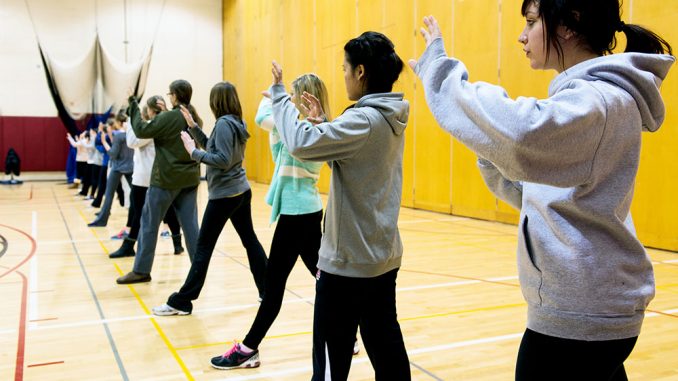
Instructors from the class Personal Defense for Women are taking pop quizzes to a new level.
Students must prepare for surprise assessments from the three officers in charge of the kinesiology class, who said they sneak up on students outside of class to test their alertness and defense tactics.
“After this class, you’ll throw a lot of punches,” officer Leroy Wimberly said to his students. “And you’ll throw punches at us.”
Wimberly, officer Jonathan Woodson and officer James Friel work together to teach the class. The purpose is to increase physical safety awareness and reduce the risk of victimization.
Because the instructors are certified to train women, the class is restricted to women only.
During the course of the semester, students must create presentations about topics like stalking, educating men on sexual assault and intimate partner violence. Like other classes, they have homework assignments, a midterm and a final.
However, students will use the skills they learn to physically combat their instructors during what the officers call “dynamic simulation.” They’ll learn various hand strikes and kicks, as well as how to defend themselves from elbow strikes, wrist grabs and chokeholds.
To minimize the risk of injury, women must wear protective gloves, elbow pads, kneepads and masks during dynamic simulation.
Despite the protective equipment, students learn to inflict serious damage during simulations. Last semester, Wimberly suffered an elbow injury during simulation before Thanksgiving, and it has kept him out of work since.
“A girl hit me and I went down,” he said. “I went to get up, and my arm went one way while my body went the other way.”
Though painful for Wimberly, he regarded his elbow injury as a sign of progress among his students. The incident shows how drastically the women progress throughout the semester, he said.
“A lot of girls come to the first class saying they don’t know how to make a fist,” he said.
By the end of the semester, the hope is that students are able to defend themselves in a simulation against three trained police officers.
Many students who take the class are kinesiology majors, but most come to the class with a common goal of achieving confidence in their ability to defend themselves. Students like junior health professions and social work major Samantha Birmingham said they realize how important this skill is.
Last year, as a resident assistant on duty in Temple Towers, Birmingham assisted a female student who reported being raped. Birmingham said she and the traumatized student sat alone in silence for at least an hour before the student was ready to talk.
“It hit me how scary it must be to be totally alone and vulnerable,” Birmingham said. “I never want to be in that situation, and if I am, I want to be able to defend myself.”
Woodson, who has been teaching self-defense for about 15 years, said many women who take the class say they have been sexually assaulted.
“Some of the physical stuff brings up memories for them, it becomes emotional,” Woodson said. “What we believe is when they overcome being traumatized from that event, we can help them come through with confidence.”
Wimberly said he believes it is essential to build a relationship with the students early on in order to ensure they are comfortable talking about such issues.
“We take each one of [the students] personally,” he said. “We feel as though [they are] our responsibility.”
Though the seriousness of the subject matter could often create the potential for a heavy and somber class environment, Wimberly said he frequently tries to lighten the mood by joking with the students. It’s best to keep the class on a positive note, instructors said, even when there are troubling events that need to be confronted.
Serious issues like the recent shooting in Northern Liberties that occurred when a young woman resisted surrendering her purse to her attacker are addressed.
“If someone wants to rob you, give it to them,” Woodson said. “Your keys, your wallet and your license can all be replaced. Your life cannot.”
Instructors stress lessons like that are just as important as acquiring the physical skills necessary for self-defense.
“We’re going to turn you into warriors against the people who will harm and hurt you,” Wimberly said.
Claire Sasko can be reached at claire.sasko@temple.edu.



Be the first to comment